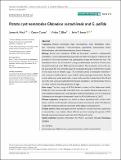Files in this item
Potato cyst nematodes Globodera rostochiensis and G. pallida
Item metadata
| dc.contributor.author | Price, James A. | |
| dc.contributor.author | Coyne, Danny | |
| dc.contributor.author | Blok, Vivian C. | |
| dc.contributor.author | Jones, John T. | |
| dc.date.accessioned | 2021-03-17T13:30:12Z | |
| dc.date.available | 2021-03-17T13:30:12Z | |
| dc.date.issued | 2021-05 | |
| dc.identifier | 273295380 | |
| dc.identifier | 7e48f9c0-eba1-4f85-add3-939f406952ad | |
| dc.identifier | 85102611829 | |
| dc.identifier | 000627600400001 | |
| dc.identifier.citation | Price , J A , Coyne , D , Blok , V C & Jones , J T 2021 , ' Potato cyst nematodes Globodera rostochiensis and G. pallida ' , Molecular Plant Pathology , vol. 22 , no. 5 , pp. 495-507 . https://doi.org/10.1111/mpp.13047 | en |
| dc.identifier.issn | 1464-6722 | |
| dc.identifier.other | RIS: urn:27A00F8B34EB01C1E1AA466860B478A2 | |
| dc.identifier.uri | https://hdl.handle.net/10023/21647 | |
| dc.description | Innovate UK. Grant Number: 105653 (RESOLVE) Rural and Environment Science and Analytical Services Division. Grant Number: WP2.1 Scottish Funding Council. Grant Number: ODA GCRF XFC105 | en |
| dc.description.abstract | Taxonomy: Phylum Nematoda; class Chromadorea; order Rhabditida; suborder Tylenchina; infraorder Tylenchomorpha; superfamily Tylenchoidea; family Heteroderidae; subfamily Heteroderinae; Genus Globodera. Biology: Potato cyst nematodes (PCN) are biotrophic, sedentary endoparasitic nematodes. Invasive (second) stage juveniles (J2) hatch from eggs in response to the presence of host root exudates and subsequently locate and invade the host. The nematodes induce the formation of a large, multinucleate syncytium in host roots, formed by fusion of up to 300 root cell protoplasts. The nematodes rely on this single syncytium for the nutrients required to develop through a further three moults to the adult male or female stage. This extended period of biotrophy?between 4 and 6 weeks in total?is almost unparalleled in plant?pathogen interactions. Females remain at the root while adult males revert to the vermiform body plan of the J2 and leave the root to locate and fertilize the female nematodes. The female body forms a cyst that contains the next generation of eggs. Host range: The host range of PCN is limited to plants of the Solanaceae family. While the most economically important hosts are potato (Solanum tuberosum), tomato (Solanum lycopersicum), and aubergine (Solanum melongena), over 170 species of Solanaceae are thought to be potential hosts for PCN (Sullivan et al., 2007). Disease symptoms: Symptoms are similar to those associated with nutrient deficiency, such as stunted growth, yellowing of leaves and reduced yields. This absence of specific symptoms reduces awareness of the disease among growers. Disease control: Resistance genes (where available in suitable cultivars), application of nematicides, crop rotation. Great effort is put into reducing the spread of PCN through quarantine measures and use of certified seed stocks. Useful websites: Genomic information for PCN is accessible through WormBase ParaSite. | |
| dc.format.extent | 13 | |
| dc.format.extent | 1086958 | |
| dc.language.iso | eng | |
| dc.relation.ispartof | Molecular Plant Pathology | en |
| dc.subject | Genome sequence | en |
| dc.subject | Globodera | en |
| dc.subject | Host–parasite interactions | en |
| dc.subject | Potato cyst nematodes | en |
| dc.subject | QH301 Biology | en |
| dc.subject | SB Plant culture | en |
| dc.subject | T-DAS | en |
| dc.subject.lcc | QH301 | en |
| dc.subject.lcc | SB | en |
| dc.title | Potato cyst nematodes Globodera rostochiensis and G. pallida | en |
| dc.type | Journal article | en |
| dc.contributor.sponsor | Scottish Funding Council | en |
| dc.contributor.institution | University of St Andrews. School of Biology | en |
| dc.contributor.institution | University of St Andrews. Biomedical Sciences Research Complex | en |
| dc.contributor.institution | University of St Andrews. St Andrews Bioinformatics Unit | en |
| dc.identifier.doi | https://doi.org/10.1111/mpp.13047 | |
| dc.description.status | Peer reviewed | en |
| dc.identifier.grantnumber | en |
This item appears in the following Collection(s)
Items in the St Andrews Research Repository are protected by copyright, with all rights reserved, unless otherwise indicated.

